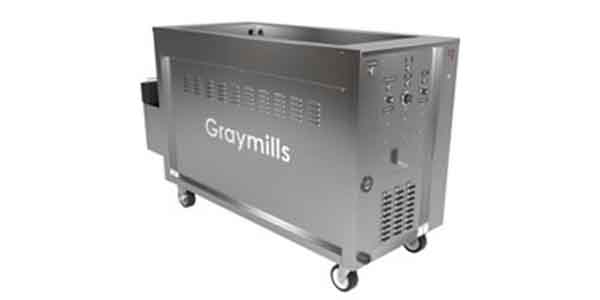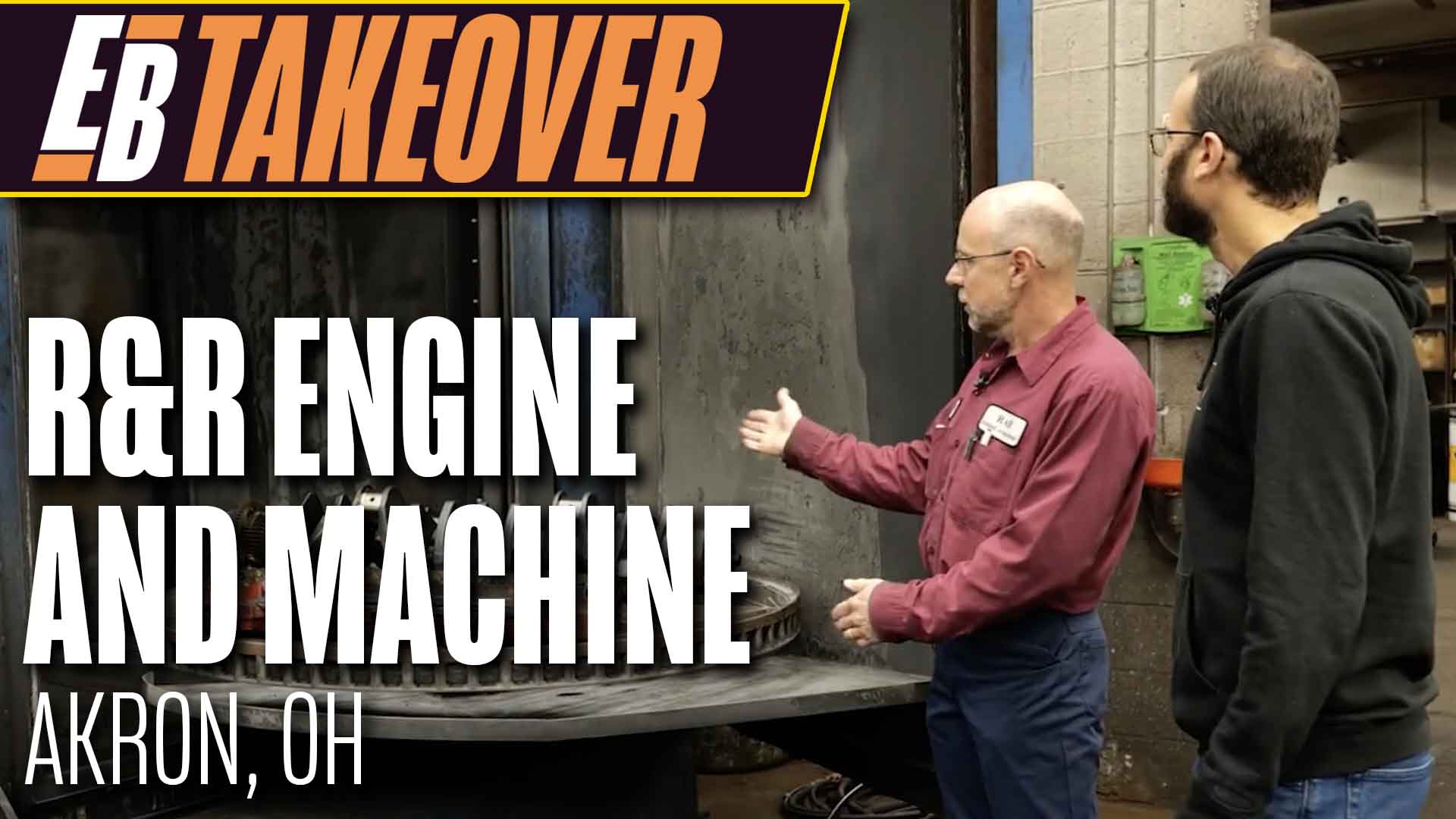Do They Deserve a Space in Your Shop?
When it comes to cleaning equipment, one solution that doesn’t get mentioned enough are parts tumblers. Parts tumblers are utilized in a wide range of industries – a primary one being automotive. Two of the most common applications of parts tumblers are rotary parts tumblers and vibratory parts tumblers, and the advantages of each type must be carefully considered if you’re thinking of adding one or more to your shop.
While rotary tumblers are very quiet, vibratory tumblers offer increased load capacity, decreased finishing time and a smoother polish. These two main tumblers are fairly similar in construction. A rotary parts tumbler consists of a hexagonal or cylindrical barrel, a base, a drive, a motor and a gear assembly. In order to create the deburring action, a rotary parts tumbler utilizes rotational movement with the addition of abrasive tumbling media that enables a sliding action to occur. Various types of tumbling media include small abrasive steel, ceramic, plastic, and organic media such as corn cob and walnut shells.

Vibratory parts tumblers consist of many of the same basic parts and function by agitating in a side-to-side motion at high rates of speed, causing friction to occur and, thus, continuous grinding amongst the enclosed parts. Both types of parts tumblers can be used for wet and dry deburring.
When it comes to finding these machines and which one might be right for your shop, look no further than Giant Finishing, one of the leaders in the deburring and finishing industry. Founded by Miro Oryszczak in the late-‘80s, and today led by his son Mark Oryszczak, Giant Finishing provides a full line of vibratory finishing bowls, vibratory deburring tubs, finishing ovals, continuous flow deburring and finishing equipment systems, vibratory corn cob dryers, inline aqueous washers, heated dryers, and high energy deburring and finishing centrifugal barrel tumblers.
Giant Finishing is a one-stop shop to get all of your vibratory deburring and finishing chemicals or compounds along with the correct vibratory deburring or finishing media. Few know it better than Mark Oryszczak, who is known by many in the industry as their ‘vibe guy.’

“That’s what I ended up getting for my license plates,” Oryszczak says. “For engine builders, these machines are another tool. It depends on if they’re looking to deburr, polish, surface finish, or descale. Those are all different processes, but can be done in different tumbler machines. These machines are tools just like an oven. If you want to make a pie, a pizza, a cake, casserole, lasagna – they all require different ingredients and different settings, maybe even a different style oven.
“The type of tumbler depends on what you’re looking to do and the type of part you’re looking to use the machine on. Are you going to do a crankshaft? Are you going to do set of headers? Are you looking to do valves? A lot of machines are universal and it’s the process that changes. If you just change the abrasives, the chemistry and the settings on the machine to go from a fine polish or prep for planing or anodizing to something rough and aggressive for heavy decreasing, deburring, descaling, or even going to a surface finish improve – there’s a wide array of things you can do. It’s a very versatile set of machines.”
Like most equipment, what kind of tumbler and how many a shop needs depends on what a particular shop is looking to achieve.
“The machine sometimes depends on the part,” Oryszczak says. “If you’re doing everything from a crankshaft to bolts, you might have two machines. One machine to handle parts A through D and another smaller machine to handle the next set of parts.

“One of our most popular machines is our model W5 – it’s a rectangular tub that looks like a big, blue chest. It’s hands down the most popular machine out there because it’s very versatile. It’s got a 19˝ x 35.5˝ compartment, and it works well on most parts. The problem or frustration that someone might have is it’s not the best machine for small parts like bolts.
“Things of that nature for those little parts you have to hand pick out, digging through it is going to be a pain in the ass. For parts like that, you get yourself one of the round, vibratory bowls with the internal separation that can help you screen those parts out. You don’t want to spend money and time on a guy sitting there fishing for parts. He could let the machine do the work.”
While the type of tumbler may vary for each shop, the engine parts that can be cleaned and deburred are fairly vast. Components such as piston rings, pinions, crankshafts, connecting rods, camshafts, lifters, headers, and valves can all be put in a tumbler. And as for media use, there are thousands of different sizes, shapes and compositions to choose from.

“We tell the customer to rely on us,” he says. “Let us help you determine what media is best suited for your needs. We don’t expect the customer to know exactly what to do because it’s finish is very unique. We deal with a lot of engine builders and guys doing restorations and performance automotive work.”
Something many might not know is that these vibratory machines and parts tumblers can be multi-purpose machines.
“Say you want to deburr and you’ve got oily parts, so you’re kind of cleaning and deburring at the same time,” he says. “You’re breaking the edges and cleaning off the grease, so it’s almost like turning it into a mechanical washer where you use an aqueous decreasing solution mixed in with water. The media, as it vibrates, acts like millions of little scrub brushes that wipe the part clean as opposed to using a hot tank or a spray cabinet washer or ultrasonics. You turn the vibe into a mechanical washer where it’s actually rubbing and wiping the part clean.”
As opposed to some of the other cleaning options out there for the automotive industry, this one is much more hands off, according to Oryszczak, which is a big advantage to this method.
“It eliminates and minimizes operator labor and error,” he says. “As opposed to doing things by hand, it’s more or less set it and forget it. It also offers you consistency. I say this jokingly, but also with some seriousness, but the machine shows up every day, on time, sober, and with no drama. People relate to that. It eliminates some of the issues owners have of dealing with people and personnel.

“One of the two things that drive cost up in this country is people/labor and space. These machines help eliminate one of those. You can utilize it to let that person be effective someplace else. It’s not that these machines are taking jobs, but rather that they’re taking mindless jobs, and nobody wants to do those mindless jobs anymore. It minimizes labor and delivers consistency in the job.”
While these machines can operate without someone hovering over it, they can also be paired with something like a slurry blaster to complement the clean because it can get into the nooks and crannies where your traditional vibratory finishing medias can’t reach or would get lodged.
“The one thing with our stuff is we’re putting the final finish on the part,” he says. “We’re making it better. We’re making it prettier. We’re making it smoother. Smoother is usually faster. We’re making it last longer and giving it more strength because we’re removing the stress risers. We’re giving shops an added benefit that most people don’t realize.”

Getting those benefits out of the parts being cleaned will take some time – anywhere from minutes to hours depending on the part and what you’re trying to accomplish.
“It could be minutes if they’re just trying to clean,” Oryszczak says. “If they’re trying to surface finish improve, that could take hours. We can automate that procedure, but once we establish a process it’s like having a recipe. Shops take that recipe and they can modify it for what’s going to best fit their needs.
“The time involved in these types of jobs also depend on how good of a part you’re starting with. The better the part, the less time it’s going to spend in a vibe. And, beauty is in the eye of the beholder. What looks good to you might look bad to somebody else. A certain polish might be good enough for most, but maybe not for others. You need to establish a guideline and go from there. We can get those critical surface finishes and those super polishes, we just need to establish where exactly that is.”
With roughly 100 different models and sizes of machines to choose from, Giant Finishing will work with you to find the right solution for your shop.
“For traditional engine builders, the wedge-style machine and the small vibratory machines are what you see,” Oryszczak says. The wedge-style machine handles crankshafts and your larger parts. Then, the Mini Giant or the GB3 or GB4 handles rocker arms, connecting rods, nuts and bolts, and things of that nature. It just depends on what exactly they’re looking to do. If they’re looking for more of a general purpose, one-size-fits-most the W5 is it. That machine is a third of my sales.”
Maybe it’s time you find a ‘vibe guy’ and add a parts tumbler to your shop? EB














